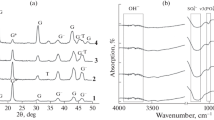Abstract
A study is reported of the formation of cements from aqueous lactic acid and aluminosilicate glass of the type used in dental glass–ionomer cements. These cements were found to set quickly, and were shown by infrared spectroscopy to have undergone a neutralization reaction to yield mainly calcium lactate. They were very soluble in water at 1 h, but became progressively less so over time; when matured for 6 h before being placed in water, they had become almost insoluble. No spectroscopic differences could be detected between the cements at 1 h or 6 h, indicating that insolubilization arises from a reaction that does not alter the part of the infrared spectrum examined. This suggested that a wholly inorganic reaction between the ion-depleted glass fragments is responsible for the formation of the insoluble structure. After 24 h, the cements were found to have compressive strengths in the range 9–35 MPa, the actual value varying with concentration of lactic acid used to form the cement, and there was no statistically significant increase in strength for the strongest of these after one month.
Similar content being viewed by others
References
S. Crisp, M. A. Pringeur, D. Wardleworth and A. D. Wilson, J. Dent. Res. 53 (1974) 1414-1419.
E. A. Wasson and J. W. Nicholson, ibid. 72 (1993) 481-483.
A. D. Wilson, J. Mater. Sci. Lett. 15 (1996) 275-276.
J. W. Nicholson, Biomaterials 19 (1998) 485-494.
P. Hatton and I. M. Brook, Br. Dent. J. 173 (1992) 275-277.
S. Matsuya, T. Maeda and M. Ohta, J. Dent. Res. 75 (1996) 1920-1927.
A. D. Wilson, R. G. Hill, C. P. Warrens and B. G. Lewis, ibid. 68 (1989) 89.
R. G. Hill, C. P. Warrens and A. D. Wilson, J. Mater. Sci. 24 (1989) 363-372.
E. De Barra and R. G. Hill, ibid. 33 (1998) 5487-5498.
V. Dupuis, F. Moya and J. Payan, Biomaterials 17 (1996) 71-74.
Z. Ouyang, S. K. Sneckenberger, E. C. Kao, B. M. Culbertson and P. W. Jagodzinski, Appl. Spectrosc. 53 (1999) 297-301.
J. W. Nicholson, B. Czarnecka and H. Limanowskashaw, Biomaterials 20 (1999) 155-158.
S. Crisp, B. G. Lewis, and A. D. Wilson, J. Dent. 5 (1977) 51-56.
Author information
Authors and Affiliations
Rights and permissions
About this article
Cite this article
Nicholson, J.W., Tawfik, H. & Czarnecka, B. A study of cements formed by aqueous lactic acid and aluminosilicate glass. Journal of Materials Science: Materials in Medicine 13, 417–419 (2002). https://doi.org/10.1023/A:1014305105445
Issue Date:
DOI: https://doi.org/10.1023/A:1014305105445



